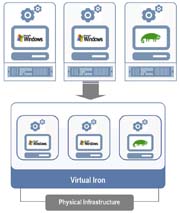The Challenge: The unimpeded growth of data centers over the last decade along with the popularity of distributed applications has resulted in a proliferation of servers, storage systems, and operating systems. Most of these applications are on isolated, single-function physical servers that are over-sized and under-utilized. The result:
- Single function servers and application silos are wasting capacity.
- Administration costs are exorbitant due to the increased complexity and lack of manageability of the data center environment.
- Managing, patching, and securing servers is cumbersome, error-prone and time consuming.
Our Solution: Virtual Iron streamlines and automates server consolidation and reduces complexity throughout the data center. The software creates an  optimized "virtual" data center that provides dynamic infrastructure built on industry standards and is flexible to changing business needs.
optimized "virtual" data center that provides dynamic infrastructure built on industry standards and is flexible to changing business needs.
The Virtual Iron platform allows a physical server of any size (from a single CPU to a 32-way multi-processor) to be partitioned into multiple virtual servers that work identically to a physical server. Each virtual server can expand as demand dictates by allocating capacity that is available on the physical server. With this capability, Virtual Iron delivers a robust server consolidation solution:
- A virtual computing platform that supports multiple virtual servers, up to 32 running concurrently, and multiple workloads per physical server; and adapts in real-time by delivering capacity based on the resource demands of the applications.
- Efficient server virtualization with minimal performance overhead; optimized to take full advantage of hardware-assisted virtualization built into today’s processors from AMD and Intel.
- Support for running unmodified 32- and 64-bit x86 guest operating systems including Windows XP, Windows Server 2003, RHEL4, and SLES 9.
- Comprehensive policy-based management of virtual infrastructure capable of handling a wide range of applications and workloads.
- Reduced risk of performance drag due to automated capacity management.
- Up to 10X improvement in resource utilization.